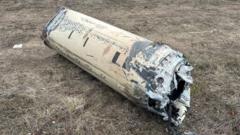In a significant escalation of hostilities, the Russian Defence Ministry has publicly acknowledged the impact of Ukrainian strikes utilizing US-supplied Atacms missiles against key military targets in Russia's Kursk region. This rare admission comes in the wake of Ukraine's assertions of having successfully engaged military installations, including an air base, linking these events to a broader shift in tactical engagements following the allowance of Atacms usage by the US.
In a statement, the Russian ministry claimed that a S-400 air defense battalion at Lotarevka was struck, emphasizing that although three out of five missiles were intercepted, two successfully hit the target, resulting in damage to a radar system and casualties. Additionally, a subsequent attack on the Khalino air base led to "insignificant damage," indicating that Ukrainian forces are adjusting their strategies to circumvent Russian air defenses.
Tensions have escalated as Russia's military confronts heightened drone attacks, with Ukrainian forces reportedly downing a substantial number of incoming threats during a single night of assault. Ukraine's air force reported a record 188 drones and Iskander missiles launched by Russia, impacting infrastructure and civilian areas. The governor of Ternopil indicated that these strikes had cut 70% of the region’s power supply.
A further factor intensifying the situation is the deployment of North Korean troops in support of Russian operations, prompting the US to furnish Ukraine with more advanced weaponry. The introduction of Atacms missiles is perceived not only as a tactical advantage for Ukraine but also as a significant shift in Western support.
Interestingly, while Ukraine reports territorial issues, with some sources claiming rapid losses, Russian advances appear to be markedly slower than earlier in the conflict, suggesting a complicated battlefield dynamic. As both sides brace for continued exchanges, Russia has claimed to be preparing retaliatory measures, and further developments are anticipated as military actions persist.
In a statement, the Russian ministry claimed that a S-400 air defense battalion at Lotarevka was struck, emphasizing that although three out of five missiles were intercepted, two successfully hit the target, resulting in damage to a radar system and casualties. Additionally, a subsequent attack on the Khalino air base led to "insignificant damage," indicating that Ukrainian forces are adjusting their strategies to circumvent Russian air defenses.
Tensions have escalated as Russia's military confronts heightened drone attacks, with Ukrainian forces reportedly downing a substantial number of incoming threats during a single night of assault. Ukraine's air force reported a record 188 drones and Iskander missiles launched by Russia, impacting infrastructure and civilian areas. The governor of Ternopil indicated that these strikes had cut 70% of the region’s power supply.
A further factor intensifying the situation is the deployment of North Korean troops in support of Russian operations, prompting the US to furnish Ukraine with more advanced weaponry. The introduction of Atacms missiles is perceived not only as a tactical advantage for Ukraine but also as a significant shift in Western support.
Interestingly, while Ukraine reports territorial issues, with some sources claiming rapid losses, Russian advances appear to be markedly slower than earlier in the conflict, suggesting a complicated battlefield dynamic. As both sides brace for continued exchanges, Russia has claimed to be preparing retaliatory measures, and further developments are anticipated as military actions persist.




















